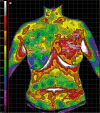Determining the Definitive Time Criterion for Postherpetic Neuralgia Using Infrared Thermographic Imaging
- PMID: 35284992
- PMCID: PMC9098764
- DOI: 10.1007/s40122-022-00370-4
Determining the Definitive Time Criterion for Postherpetic Neuralgia Using Infrared Thermographic Imaging
Abstract
Introduction: The time criteria used in many studies of postherpetic neuralgia (PHN) are arbitrary and do not have supporting evidence. Therefore, this study sought to determine the definite time criterion for PHN by analyzing the skin temperature to estimate the time point when zoster-induced skin inflammatory reaction ends.
Methods: Infrared thermography was used to measure the difference in skin temperature between the affected and unaffected areas (ΔTemp) in the craniocervical and thoracic regions of patients with herpes zoster (HZ). Because the ΔTemp changes from a positive value to zero when the skin is no longer inflamed, a ΔTemp ≤ 0 was defined as the end of skin inflammation, and this time point was considered the starting point for PHN. This cutoff time point was estimated using receiver operating characteristic (ROC) curve analysis.
Results: A total of 503 patients were included in this study. The ROC curve analysis showed that the time point when the ΔTemp was ≤ 0 occurred at 12 weeks after HZ onset (95% confidence interval 11-15 weeks, area under the ROC curve 0.901). Using this time point as the time criterion of PHN, the sensitivity, specificity, and classification accuracy were 0.807, 0.905, and 0.871, respectively.
Conclusions: The transition of skin temperature from warm to cold occurs 12 weeks after HZ onset, which implies the end of local inflammation. Therefore, PHN associated with pathophysiologic change may be defined as 12 weeks after the skin rash. This finding provides a theoretical basis for the timing definition of PHN.
Keywords: Herpes zoster; Inflammation; Pathophysiology; Postherpetic neuralgia; ROC curve; Skin.
© 2022. The Author(s).
Figures



Similar articles
-
The clinical significance of infrared thermography for the prediction of postherpetic neuralgia in acute herpes zoster patients.Skin Res Technol. 2016 Feb;22(1):108-14. doi: 10.1111/srt.12237. Epub 2015 Jun 16. Skin Res Technol. 2016. PMID: 26081167
-
Impact of herpes zoster and postherpetic neuralgia on the quality of life of Germans aged 50 or above.BMC Infect Dis. 2018 Oct 3;18(1):496. doi: 10.1186/s12879-018-3395-z. BMC Infect Dis. 2018. PMID: 30285731 Free PMC article.
-
Thermography as a predictor of postherpetic neuralgia in acute herpes zoster patients: a preliminary study.Skin Res Technol. 2012 Feb;18(1):88-93. doi: 10.1111/j.1600-0846.2011.00535.x. Epub 2011 May 24. Skin Res Technol. 2012. PMID: 21605168
-
Herpes Zoster and Postherpetic Neuralgia: a review of the effects of vaccination.Aging Clin Exp Res. 2009 Jun;21(3):236-43. doi: 10.1007/BF03324909. Aging Clin Exp Res. 2009. PMID: 19571648 Review.
-
Management of herpes zoster (shingles) and postherpetic neuralgia.Expert Opin Pharmacother. 2004 Mar;5(3):551-9. doi: 10.1517/14656566.5.3.551. Expert Opin Pharmacother. 2004. PMID: 15013924 Review.
Cited by
-
Letter to the Editor Regarding "Determining the Definitive Time Criterion for Postherpetic Neuralgia Using Infrared Thermographic Imaging".Pain Ther. 2022 Sep;11(3):1079-1080. doi: 10.1007/s40122-022-00398-6. Epub 2022 Jun 14. Pain Ther. 2022. PMID: 35699896 Free PMC article. No abstract available.
-
Immune Dysregulation in Acute Herpes Zoster: Predictive Factors for Postherpetic Neuralgia.Med Sci Monit. 2025 Feb 8;31:e944688. doi: 10.12659/MSM.944688. Med Sci Monit. 2025. PMID: 39921244 Free PMC article.
-
A Response to: Letter to the Editor Regarding "Determining the Definitive Time Criterion for Postherpetic Neuralgia Using Infrared Thermographic Imaging".Pain Ther. 2022 Sep;11(3):1081-1083. doi: 10.1007/s40122-022-00399-5. Epub 2022 Jun 14. Pain Ther. 2022. PMID: 35699897 Free PMC article. No abstract available.
References
LinkOut - more resources
Full Text Sources

